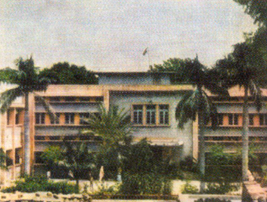3. IN THE WAKE OF KNOWLEDGE
3.4 Sustainability of the model
After the passage of time, the Hyderabad STC which was so painstakingly initiated, did not continue to function as expected. The Madras STC also was not keen to train DTP key personnel. The situation nearer home in Karnataka, at the LWSTC, was not different. The laboratory facilities were not appropriate and there was no effective drug surveillance. Most of the STCs were not effective in training or supervision of DTCs under their jurisdiction due to lack of staff and other facilities. The qualified staff when retired or transferred were not replaced by suitable personnel. The NTI could enthuse them even less because of logistics and perseverance required for this task.
|
Dr. ML Mehrotra Director, |
STC, Agra |
The TB Demonstration and Training Centre (later known as STC) at Agra, sets an example of how advocacy, commitment and highly motivated people can make a difference between success and failure of institutions. This centre was established in 1962 by the Uttar Pradesh government with the assistance of GOI, WHO, UNICEF with Dr ML Mehrotra as its Director. He overcame every obstacle to make the centre one of the best in the region. He ensured that his workforce consisted of qualified doctors with post-graduate (PG) degrees and qualified para medical staff, enriched with additional qualifications to specially enable them to participate in teaching, training and research work besides routine clinical work. It had competent statisticians. The centre possessed all facilities needed for TB work, including a well equipped library and laboratory that could take up culture and sensitivity work. Besides hostel for trainees, beds for TB patients, a dharmashala was also maintained to house relatives of in-patients during emergencies. In 1977, its status was raised to include other chest diseases. It also conducted training courses for PG students, nurses, HVs and technicians. Its 1979 report, lists WHO, UNICEF, United Nations Economic Social and Cultural Organisation (UNESCO), IUAT and other organisations as coordinating partners. It initiated new schemes which included elective training of foreign medical students. It is not difficult to understand that such an institution led by Dr Mehrotra acquired fame and stature over years. Due to this, TB patients came from far and near. He had created an aura around his centre that nearly 300 TB patients stood daily in silence in a queue to collect their anti TB drugs; their faces covered with masks. Its support base grew53.
Unfortunately, when Dr Mehrotra left on superannuation after serving for 3 decades, the leadership weakened resulting in a laxity, that could be evidenced everywhere. The neglect in appropriate staffing and supply lines, poor patient attendance became almost a perennial reality. The infrastructure so carefully built over the years - buildings, equipment, facilities - stands there still, in contrast to the prevailing lack of effective TB services. The ups and downs are also seen in the life of such prestigious institutions of international fame.
The DTC was part of the Agra STC from its inception. The Agra DTC never developed to the expectations of NTI and PHIs also did not flourish even during the golden era of Dr Mehrotra. Was it lack of faith in the principles of NTP by Dr Mehrotra or he was too preoccupied with STC work?

